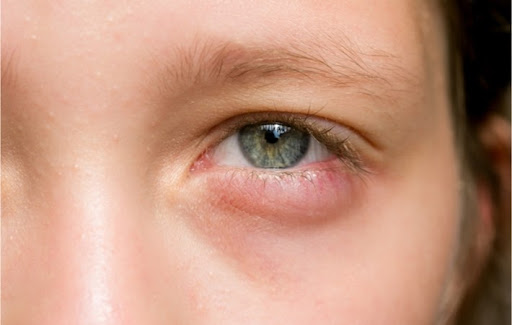Explaining Blepharitis
Patients with blepharitis will be quick to tell you about their discomfort. This common condition typically occurs when tiny oil glands near the base of the eyelashes become clogged and coated with bacteria and oily particles, leading to:
- Swollen eyelids
- Burning and irritated eyes
- Red Eyes
- Puffy Eyes
Eyelid inflammation from blepharitis can develop at any age, and thankfully, does not cause permanent vision damage and is not contagious. Although that’s great news for the patient, sadly, this condition is chronic and difficult to treat.
There are two main types of blepharitis, anterior and posterior. Patients can have anterior and posterior blepharitis concurrently:
- Anterior blepharitis: This condition affects the outer eyelid in the area surrounding your eyelashes, and can be caused by a bacterial or viral infection. Anterior blepharitis may lead to thickened, inward-turned, or outward-turned eyelids.
- Posterior blepharitis: This condition occurs due to dysfunctioning oil glands (meibomian glands) in the eye. Posterior blepharitis can cause styes, thickened and crusty eyelids, and tears that look like foam.
The Varying Causes of Blepharitis
Experts have not yet determined the exact cause of blepharitis, but it could result from one of the following conditions:
- Seborrheic dermatitis
- Infections
- Malfunctioning oil glands in the eyelids
- Clogged oil glands in the eyelids
- Rosacea
- Allergic reactions to products like eye medications, contact lens solutions, or eye makeup
- Eyelash mites
- Lice
- Dry eye disease
The Symptoms of Blepharitis
Patients may find that symptoms of blepharitis are worse in the morning.
- Itchy eyelids
- Sore eyelids
- Red eyelids
- Crusting eyelashes
- Greasy eyelashes
- Burning or gritty sensation in the eyes
- Sensitivity to light
- Swollen eyelids
- Abnormal eyelash growth
- Loss of eyelashes
Contact your optometrist if you experience any of these symptoms, or book a comprehensive eye exam.

Relief from Blepharitis
BlephEx is an entirely painless procedure performed in-office by your optometrist, which helps reduce or alleviate the symptoms of blepharitis.
This treatment removes excess bacteria and toxins living along the lash margins that cause inflammation and disease. Utilizing the BlephEx handpiece, your optometrist carefully spins the medical-grade disposable micro-sponge along the edge of the eyelids and lashes.
A BlephEx treatment takes about 6 to 8 minutes to remove any scurf (flakes on the skin’s surface), discard debris, and exfoliate the eyelids.
After the procedure, your optometrist will provide maintenance instructions and options for nightly lid hygiene to ensure the eyelids stay clean and healthy.
The Magic of BlephEx
Eyelids are challenging to clean, and without proper care, an overgrowth of bacteria, biofilm, scurf, and debris can accumulate. The exotoxin-induced inflammation caused by this overgrowth may result in damage to the eyelids and tear glands.
BlephEx treatments provide a pain-free, practical answer for patients with eyelid inflammation by alleviating the signs of blepharitis. Overall eye health and quality of life are significantly improved without the chronic and irritating symptoms associated with this condition.
BlephEx & Dry Eye Disease
Approximately five million Americans over 50 suffer from dry eye disease, and this condition often goes hand-in-hand with blepharitis.
Symptoms of dry eye disease are very similar to blepharitis, and only your optometrist can properly diagnose your condition. Your routine eye exam is a powerful tool to help you stay on top of your visual health.
After thorough testing and a discussion about your medical history, your eye doctor can provide a diagnosis and recommend the next steps.
BlephEx can be a solution for patients suffering from dry eye. Your optometrist may suggest a combination of treatments to reduce symptoms, providing relief and a refreshed view of the world!
How Often Should I Have BlephEx Treatments?
BlephEx treatments should be administered every 4 to 6 months, depending on the severity of the condition. Routine care is essential for keeping bacteria to a minimum, and the prevention of biofilm development.
Irregular treatments can cause biofilm redevelopment, resulting in a recurrence of inflammation and damaged tear glands.
How Quickly Does it Work?
Depending on the severity of their condition, patients will typically feel a difference in overall eye health immediately after treatment. Patients with significant damage to tear glands may not observe any changes to their condition for several weeks, and in some cases, multiple treatments may be required before they are fully healed.
Following your optometrist’s care instructions closely, a nightly eyelid hygiene regimen, and routine treatments can help prevent a recurrence.
What Are The Side Effects of Blephex Treatments?
There are no lasting adverse effects from BlephEx treatments, and any discomfort experienced post-procedure is generally mild and lasts no more than 24 hours. Some patients experience weak irritation and redness of the eyelids.
Comfort for Weary Eyes
If you have been diagnosed with blepharitis, or have looked through our list of symptoms and would like more information, contact us today at Eye Care Plus Grand.
We’re a team of experienced and compassionate people!
We’re ready to answer any questions you may have about Blephex treatment, help manage your recurring symptoms, and provide the relief you deserve.



